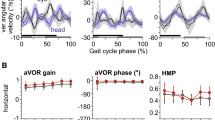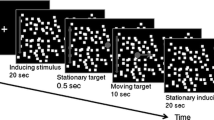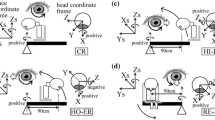Abstract
Vertical head and eye coordination was studied as a function of viewing distance during locomotion. Vertical head translation and pitch movements were measured using a video motion analysis system (Optotrak 3020). Vertical eye movements were recorded using a video-based pupil tracker (Iscan). Subjects (five) walked on a linear treadmill at a speed of 1.67 m/s (6 km/h) while viewing a target screen placed at distances ranging from 0.25 to 2.0 m at 0.25-m intervals. The predominant frequency of vertical head movement was 2 Hz. In accordance with previous studies, there was a small head pitch rotation, which was compensatory for vertical head translation. The magnitude of the vertical head movements and the phase relationship between head translation and pitch were little affected by viewing distance, and tended to orient the naso-occipital axis of the head at a point approximately 1 m in front of the subject (the head fixation distance or HFD). In contrast, eye velocity was significantly affected by viewing distance. When viewing a far (2-m) target, vertical eye velocity was 180° out of phase with head pitch velocity, with a gain of 0.8. This indicated that the angular vestibulo-ocular reflex (aVOR) was generating the eye movement response. The major finding was that, at a close viewing distance (0.25 m), eye velocity was in phase with head pitch and compensatory for vertical head translation, suggesting that activation of the linear vestibulo-ocular reflex (lVOR) was contributing to the eye movement response. There was also a threefold increase in the magnitude of eye velocity when viewing near targets, which was consistent with the goal of maintaining gaze on target. The required vertical lVOR sensitivity to cancel an unmodified aVOR response and generate the observed eye velocity magnitude for near targets was almost 3 times that previously measured. Supplementary experiments were performed utilizing body-fixed active head pitch rotations at 1 and 2 Hz while viewing a head-fixed target. Results indicated that the interaction of smooth pursuit and the aVOR during visual suppression could modify both the gain and phase characteristics of the aVOR at frequencies encountered during locomotion. When walking, targets located closer than the HFD (1.0 m) would appear to move in the same direction as the head pitch, resulting in suppression of the aVOR. The results of the head-fixed target experiment suggest that phase modification of the aVOR during visual suppression could play a role in generating eye movements consistent with the goal of maintaining gaze on targets closer than the HFD, which would augment the lVOR response.
Similar content being viewed by others
Author information
Authors and Affiliations
Additional information
Received: 23 November 1998 / Accepted: 17 May 1999
Rights and permissions
About this article
Cite this article
Moore, S., Hirasaki, E., Cohen, B. et al. Effect of viewing distance on the generation of vertical eye movements during locomotion. Exp Brain Res 129, 347–361 (1999). https://doi.org/10.1007/s002210050903
Issue Date:
DOI: https://doi.org/10.1007/s002210050903




